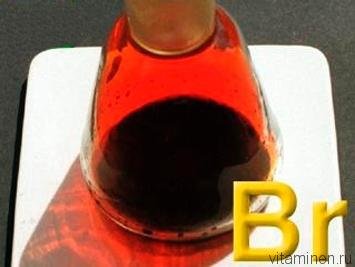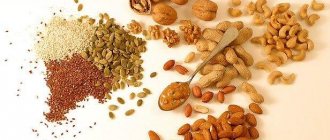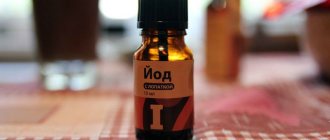October 18, 2011
Poisonous in nature, bromine is vital for humans. It regulates the activity of the nervous system and helps in the digestion of food.
Bromine in nature is a toxic red-brown liquid with an unpleasant odor. Even the name of this element comes from the Greek word for “stench.” However, this dangerous substance is an essential microelement for the human body. It regulates the activity of the central nervous system and thyroid gland. Fortunately, bromine compounds found in food and drinking water are non-toxic. And the widespread legend that bromine reduces libido is another myth.
Source of bromine for the body
Bromine is a fairly common trace element that a person can consume daily without even realizing it. Bromine is found in:
- pasta products;
- nuts: chickpeas (Turkish nuts), peanuts, cashews, almonds and hazelnuts;
- legumes and grain food products.
Much less bromine can be found in fish and dairy products.
The role of microelements and biologically active food additives
The bromine content in the human body (body weight 70 kg) is 260 mg. Bromine is found in the blood, brain, liver, and kidneys. Most of it is in the brain. In the pituitary gland (an appendage of the brain), bromine is 25–50 times more than in the blood, and 15–20 times more than in the liver.
Biological role of bromine and its compounds. Physiologist I.P. Pavlov said: “Humanity should be happy that it has such a precious drug for the nervous system as bromine.” With nervous diseases, the amount of bromine in the blood and brain decreases. Bromides, widely used as medicines, when entering the body, decompose with the release of bromine ions, which do not suppress excitation processes, but enhance inhibition processes, i.e., they help restore the correct balance of these processes in the brain. This is the healing effect of bromine preparations on the nervous system.
The physiological role of bromine and its compounds in our body is also manifested in its effect on the thyroid gland. Iodine is required for the formation of thyroid hormones. Bromine ions, entering the body for a long time, prevent the accumulation of iodine ions in the thyroid gland and thereby inhibit its activity.
Sources of bromine in the human body. Bromine enters the body mainly through food products of plant origin, as well as through the consumption of bromine-containing mineral waters. The less chlorides and other salts the water contains, the more clearly the effect of bromine on the human body is manifested.
Application of bromine and its compounds. The toxicity of bromides is low. They are used mainly for hysteria, neurasthenia and other neuroses. However, with very long-term use of bromides and due to their slow release from the body, Br– ions can accumulate in the body in large quantities, which leads to the development of chronic poisoning - bromism. Bromism is characterized by signs of depression of higher nervous activity: apathy, drowsiness, weakening of memory are observed; a rash appears on the skin (usually acne-like), catarrhal phenomena are observed - the mucous membranes swell, a cough and runny nose begin. To speed up the removal of bromides from the body, you should prescribe a diet with a high content of sodium chloride (up to 10–20 g per day) and drink plenty of fluids (up to 3–5 liters of water per day). To prevent bromism, it is recommended to keep the skin clean (frequent washing), rinse your mouth and systematically (once a week) take saline laxatives (magnesium or sodium sulfate).
Metals that make up living organisms play a huge role in their life. They stimulate normal metabolism, actively participate in hematopoiesis, influence growth, reproduction and heredity. That's why they are called the metals of life. These include iron, zinc, copper, selenium, manganese, calcium, cobalt, etc. Knowledge about them has made it possible to find fundamentally new approaches to the treatment of many diseases that were previously considered incurable.
The role of iron in human life. Despite the low iron content in the human body (2-5 g in adults and 340-400 mg in newborns), it is a unique microelement in its importance. As part of the blood, iron is involved in the transfer of oxygen from the lungs to all tissues, organs and systems of our body. The vital activity of all cells is impossible without a constant supply of energy, the production of which is ensured by complex biochemical reactions occurring in them, involving oxygen.
The involvement of the central nervous system (CNS) in the pathological process in ID is confirmed by the lag in the psychomotor development of children, the impoverishment of their emotional sphere with a predominance of bad mood, lethargy, irritability, and tearfulness. Schoolchildren's ability to concentrate is significantly reduced, they quickly get tired, and their intelligence index decreases. In addition, low blood pressure, frequent dizziness and rapid heartbeat may occur. In children in the first 5 years of life, anemia is diagnosed when the hemoglobin level in the blood is below 110 g/l, in children over 5 years of age and adults - when the level is below 120 g/l.
External manifestations of iron deficiency:
How much iron does a person need? Our body contains from 2 to 5 g of iron, depending on the level of hemoglobin, weight, height, gender, age. It is especially abundant in blood hemoglobin - 2/3 of the total amount, the rest is stored in tissues and internal organs, mainly in the liver. Iron from food is absorbed in the intestines and transported to the blood vessels, where it is captured by a special transport protein, transferrin. It performs a function similar to hemoglobin, only it transports iron rather than oxygen. Iron is transported mainly to the bone marrow, where red blood cells are constantly formed, the lifespan of which is on average 120 days. A small part of it ends up in the liver and spleen, where it is stored as a reserve fund. The remaining small part of the iron goes to the formation of myoglobin and some enzymes of tissue respiration.
- gynecological: menstrual dysfunction; Irregularity of menstruation, sometimes absence of menstruation; infertility; mastopathy; irritation and cracked nipples.
Sources of iodine in the human body. However, the body can lose iodine if a person eats salty foods or drinks chlorinated water. This phenomenon is explained by the substitution property of halogens, which is expressed by the law: any of the four halogens can replace an element with a higher atomic mass and cannot replace an element with a lower atomic mass. Fluorine can replace chlorine, bromine, iodine, because it has a lower atomic mass. Like fluorine, chlorine displaces iodine. The reverse process is not possible. When cooking food, an average of 20–60% of iodine is lost. Iodine is also lost if the rules for storing iodized salt are not followed (6 months in a wooden container, in a dry place). The intake of iodine decreases when eating cabbage and cauliflower.
The body's reaction to iodine deficiency. With insufficient intake of iodine in the body, the function of the thyroid gland decreases and hypothyroidism develops. The thyroid gland is formed at 4–5 weeks of intrauterine development, and at 6–8 weeks the first signs of its hormonal activity appear. If there is insufficient amount of iodine in the body, especially during the prenatal period and the first months of life, the disease cretinism (severe mental and physical development disorders) can occur - the most severe form of hypothyroidism. It is very important to make a correct diagnosis in the first month of a child’s life, and this is only possible using a blood test, since clinical manifestations of the disease in most cases appear much later (at 3–4 months of life). These include increased child sleepiness, poor appetite, constipation, poor weight gain, dry skin, umbilical hernia, etc.
With a lack of iodine in adults, the thyroid gland increases in size in order to capture as much iodine from the bloodstream as possible and provide the body with enough hormones. Outwardly, this manifests itself in an enlargement of the thyroid gland itself in the form of a swelling on the front surface of the neck (goiter). A condition called myxedema develops. Symptoms of a lack of thyroid hormones in the body are a decrease in metabolism, a drop in body temperature, calluses on the toes, numbness and goose bumps in the hands at night, hair loss, lethargy, weakness, dry yellowish skin, and puffiness occurs. Myxedema is treatable, but patients must regularly take appropriate hormonal drugs obtained from the thyroid glands of farm animals throughout their lives. To prevent the development of goiter, iodine deficiency is compensated by taking iodized table salt NaCl, to which KI is introduced (25 g per 1000 kg of salt).
Bromine dosages

As mentioned above, the daily requirement of bromine is from 3 to 8 mg, although a person consumes on average about 1 mg per day with a balanced diet. Thus, it is recommended to structure your daily diet so that the presence of bromine-containing foods in it exceeds all other foods.
Despite the fact that bromine is very necessary for the body, it is also important to understand that it is very easy to get an excess of this trace element. 35 mg of bromine is a dose that can be fatal. Even if you have excess bromine, you urgently need to take laxatives that will remove it from the body without any problems.
Shortage and surplus
Signs of bromine deficiency in the body:
- decreased hemoglobin levels;
- insomnia;
- increased irritability;
- growth retardation in adolescents;
- reducing the acidity of gastric juice;
- sexual weakness.
Lack of a microelement shortens a person's life expectancy, causes nervous system disorders, and increases the likelihood of spontaneous abortion. To eliminate bromine deficiency, it is recommended to enrich the diet with food products or take vitamin and mineral complexes that contain a beneficial compound.

Symptoms of excess mineral:
- dizziness;
- nosebleeds;
- skin rashes;
- speech disorders;
- vomit;
- diarrhea;
- myalgia;
- ataxia;
- irritation of the mucous membranes of the eyes;
- disruption of the digestive system and nervous system;
- cough, spasm of the respiratory tract;
- memory impairment, insomnia.
Contact of bromine compounds, including bromides, on the skin causes severe, difficult-to-heal burns. Therefore, the place of contact of the microelement with tissues must be urgently rinsed repeatedly with water, then treated with a 50% sodium hyposulfite solution, and lubricated with an ointment that includes baking soda.
Reasons for excess minerals in the body: metabolic disorders, intake of microelements from food, medications, vapors in excess quantities.
In case of bromine poisoning, the victim should first of all be taken out into clean air and a swab soaked in ammonia should be brought to the nose. Then induce vomiting, give laxatives and activated charcoal to remove excess element from the body. Further treatment involves drinking plenty of fluids (drinking mineral water, warm milk) and inhaling a solution of sodium thiosulfate 2% under the supervision of a doctor.
If the symptoms of overdose are not stopped, enteritis, bronchitis, rhinitis, bromoderma disease, conjunctivitis, hallucinations develop, and in case of chronic poisoning, suffocation may occur.
Remember, bromine vapor is especially dangerous for asthmatics, as it can cause pulmonary edema, acute toxic inflammation of the larynx and trachea.
History of discovery
Br itself was first described in 1826 by Antoine Balard, a preparator from Montpellier. The young scientist obtained a dark brown liquid from burned seaweed and called it murid (by analogy with the Latin muria, that is, “brine”). Although a little earlier, in 1825, Professor Gmelin’s assistant, student Levig, using chlorine, isolated the element from the Kreuznach source. True, while the German was collecting a sufficient amount of material for research, the Frenchman was ahead of him by announcing his discovery.
In any case, the assessors of a specially assembled commission (among whom was the famous Gay-Lussac) from the Paris Academy of Sciences conferred and recognized the name Balard as unsuccessful. The fact is that at that time the family of hydrochloric acid salts was given the name muriata. So scientists thought that too similar terms would cause confusion, and instead proposed the variant Brome (translated from Greek as “fetid”), because the discovery smelled bad. It was introduced into use all over the world, naturally, adjusted for linguistic features.
Preparations based on bromide
In medicine, preparations of potassium bromide, ammonium, sodium, as well as bromoform are used. When treating neurological and mental pathologies, up to 3 g of medication per day is prescribed, in rare cases higher dosages are used.
Important! Bromine-based drugs belong to the group of outdated drugs with a very low price and a large number of side effects.
One of the most common preparations based on potassium bromide and spring adonis is Adonis-Bromine .
Preparation of bromine water: preparation, application, color
First, a few words about Br himself. At stable room temperature, it is liquid (and is the only non-metal with this state) and has the same characteristics as halogens. In terms of its reactivity, it is between chlorine and iodine. Visually, it is viscous and red-brown, just like NO2, but it is impossible to confuse them due to the smell, which is pronounced and negatively perceived by the sense of smell.
The element is ubiquitous today, and its highest content is recorded in salt lakes and seas (from where it can also enter fresh water sources). Due to its higher density, bromine dissolves in water very easily, making it orange.
There are two cooking methods - let's look at each. According to the first method, you need:
- take 4 ml of Br and 1 liter of distilled H2O;
- mix them vigorously in a closed flask.
Despite the apparent simplicity of the action, it is important to exercise extreme caution and work only in protective clothing and in a fume hood. This is because when the two components combine, toxic fumes are released.
A safer, and therefore more convenient option is to split the powder with NaBr and use bleach (with chlorine, but without additives or flavors) and HCl. It happens in the following way:
- the ingredients are combined in a glass;
- the resulting solution is sent to a clean container (bottle), into which household chemicals are poured;
- close the reservoir with a lid, checking the tightness of its fit, and shake gently;
- the result is mixed with distillate H2O.
Methods of obtaining
Based on the nature of the equipment’s use, they can be divided into two types - let’s consider both.
Mechanical - we have already described it before, but for reinforcement we will provide another example with other concentrations. So, you will need:
- 1 ml Br and for every 250 ml distilled H2O;
- closed flask for mixing components;
- fume hood and protective clothing for the safety of the process.
Among the disadvantages, we remind you, are toxic fumes. After preparation, the liquid must be stored in an opaque and airtight glass container.
Electrochemical - in this case the scheme is as follows:
- an aqueous solution of KBr, NaBr or another alkali metal with a concentration of 60 g/l is sent to the electrolyzer;
- under a current density of 1 kA/m2, the flow is supplied to the MF-4SK-100 membrane;
- this filter traps Na particles and passes Br, which, when interacting with H2O, forms Br2 and accompanying acids (HBr, HBrO).
The advantage of this technology is that all its stages can be carried out without being in close proximity to substances, and therefore without inhaling toxic fumes and without the risk of getting burned by a drop accidentally falling on the skin. Another plus is on an industrial scale, because when producing liquid, the volume is not limited by the size of the flask.
Chemical properties
Like halogen mixtures, it is an excellent oxidizing agent, although in this regard it is slightly inferior to a chlorine solution. Effectively oxidizes manganese, iron, nickel, cobalt, chromium, and other metals. Phenols appear in a separate line; when added, the substituted compounds will precipitate. This operation is performed with a small infusion of H2O as a catalyst (otherwise it would take several days).
The most important feature is the qualitative reaction of interaction with bromine water: if it becomes discolored when an organic compound is introduced, it means that the additive contains at least one double bond CC, and the hydrocarbon taken as a sample is unsaturated.
In each case, it is a radical replacement that occurs, so a prerequisite for the effective course of the experiment is the presence of catalysts and/or bright light.
Everything is explained by electrophilic addition, and this pattern is especially clearly visible when any alkyne or alkene, for example, ethylene, passes through the medium. Br atoms will begin to join at the break sites, continuing the chains. And if we take formic acid as an example, then H and CO2 will also be released (sulfur dioxide, bromine, water - a characteristic combination).
Physical properties
A viscous yellow-orange liquid, possibly with a reddish-brown tint, with a clear and immediately recognizable unpleasant odor. Attention, its vapors are poisonous, so it should be stored not just in the dark, but in a hermetically sealed container.
It is also necessary to avoid contact with the skin. In the case of short-term contact, the affected area will itch quite severely, but long-term exposure threatens with painful burns or even the appearance of ulcers. Therefore, if you suddenly become careless, wash the damaged area as soon as possible, and if the wound is deep, lubricate it with NaHCO3 ointment.
Definition
This is a solution, the composition of which can be written according to the scheme:
“bromine plus water and acids” (hydrobromic and bromide)
Under normal conditions, it is a yellow-orange liquid with a high degree of transparency. It is a fairly active substance that can be successfully combined with both organic and inorganic compounds. A fairly strong oxidizing agent that quickly acts in an alkaline environment on the cations Mn+3, Ni+3, Cr+3, Co+2, Fe+2, and also, separately, on phenols.



